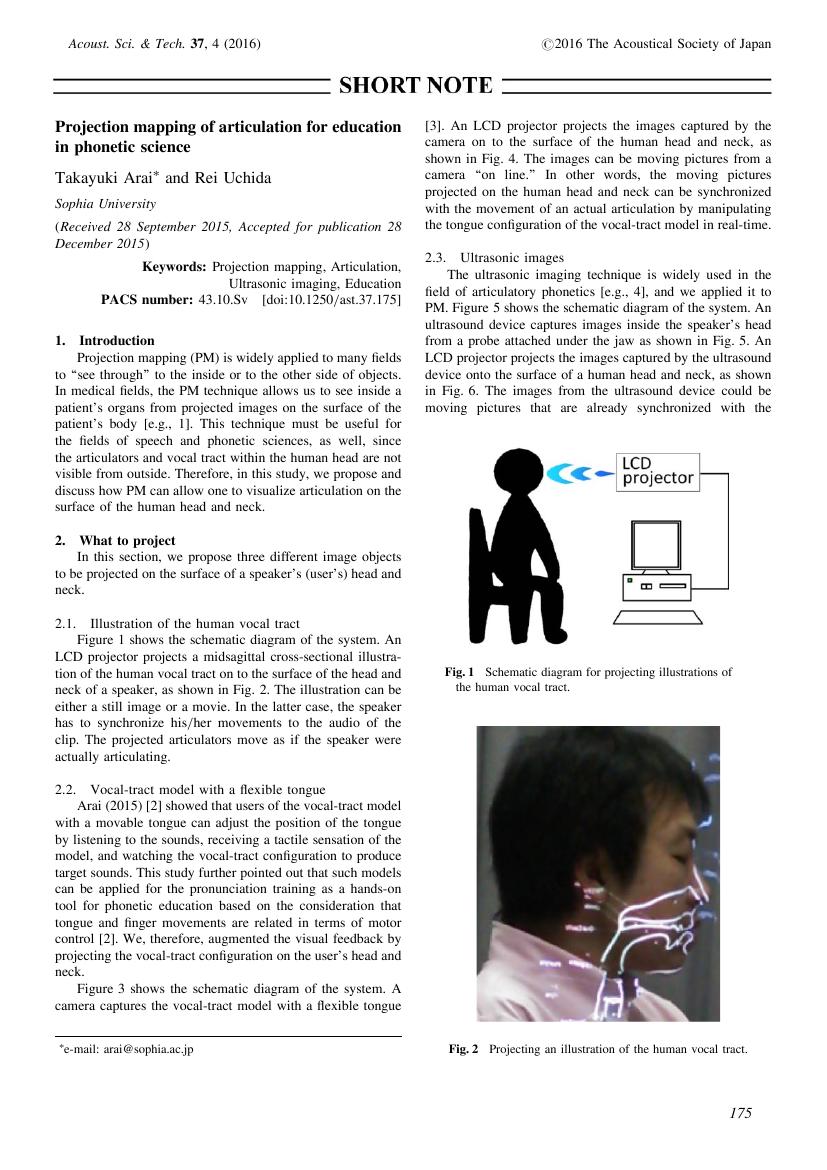- 著者
- Takayuki Arai Rei Uchida
- 出版者
- 一般社団法人 日本音響学会
- 雑誌
- Acoustical Science and Technology (ISSN:13463969)
- 巻号頁・発行日
- vol.37, no.4, pp.175-177, 2016-07-01 (Released:2016-07-01)
- 参考文献数
- 5
- 著者
- Takayuki Arai Natasha Warner Steven Greenberg
- 出版者
- ACOUSTICAL SOCIETY OF JAPAN
- 雑誌
- Acoustical Science and Technology (ISSN:13463969)
- 巻号頁・発行日
- vol.28, no.1, pp.46-48, 2007 (Released:2007-01-01)
- 参考文献数
- 10
- 被引用文献数
- 5 7
- 著者
- Jihyeon Yun Takayuki Arai
- 出版者
- ACOUSTICAL SOCIETY OF JAPAN
- 雑誌
- Acoustical Science and Technology (ISSN:13463969)
- 巻号頁・発行日
- vol.41, no.2, pp.501-512, 2020-03-01 (Released:2020-03-01)
- 参考文献数
- 25
- 被引用文献数
- 1
Previous research reported that Korean nasal consonants can be denasalized in word-initial position. This study examined the perception of word-initial nasal onset /n/ for native Korean listeners using synthesized /Ca/ stimuli with a Klatt synthesizer. We tested the effects of consonant duration, consonant nasality, and vowel nasalization on perception. In a rating experiment, listeners evaluated the goodness of the stimuli as /na/ on a seven-point scale. The participants generally gave favorable ratings to the stimuli with nasalized vowels. Two-thirds of the participants responded that the stimuli with no nasality are good exemplars of /na/, whereas the other listeners did not. In a yes-no experiment, participants judged if the stimuli were /na/ or not. They responded in similar ways they did in the rating experiment. Many listeners gave positive responses as /na/ even to the stimuli with 0 voice onset time, yet the stimuli with longer prevoicing or nasal murmur were more likely to be perceived as /na/. Vowel nasality affected the perception of /na/, while some listeners preferred oral vowels over the nasalized vowels when they evaluated the /na/-likeness.
- 著者
- Jeff Moore Jason Shaw Shigeto Kawahara Takayuki Arai
- 出版者
- ACOUSTICAL SOCIETY OF JAPAN
- 雑誌
- Acoustical Science and Technology (ISSN:13463969)
- 巻号頁・発行日
- vol.39, no.2, pp.75-83, 2018-03-01 (Released:2018-03-01)
- 参考文献数
- 27
- 被引用文献数
- 1
This study examines the tongue shapes used by Japanese speakers to produce the English liquids /ɹ/ and /l/. Four native Japanese speakers of varying levels of English acquisition and one North American English speaker were recorded both acoustically and with Electromagnetic Articulography. Seven distinct articulation strategies were identified. Results indicate that the least advanced speaker uses a single articulation strategy for both sounds. Intermediate speakers used a wide range of articulations, while the most advanced non-native speaker relied on a single strategy for each sound.
2 0 0 0 OA MyVoice: Rescuing voices of ALS patients
- 著者
- Shigeto Kawahara Musashi Homma Takaki Yoshimura Takayuki Arai
- 出版者
- 一般社団法人 日本音響学会
- 雑誌
- Acoustical Science and Technology (ISSN:13463969)
- 巻号頁・発行日
- vol.37, no.5, pp.202-210, 2016-09-01 (Released:2016-09-01)
- 参考文献数
- 22
- 被引用文献数
- 1
- 著者
- Takuya Kimura Takayuki Arai
- 出版者
- 日本音声学会
- 雑誌
- 音声研究 (ISSN:13428675)
- 巻号頁・発行日
- vol.23, pp.119-129, 2019-08-31 (Released:2019-08-31)
- 参考文献数
- 18
Beginners of Spanish whose L1 is Japanese often wonder if Spanish /y/ is similar to Japanese /y/ or to Japanese /zy/. Three perception experiments revealed that this Spanish phoneme admits a wide variety of palatal consonants as its allophones, that these consonants can be perceived by Japanese listeners sometimes as /y/ and sometimes as /zy/, or sometimes even as /gy/. In Spanish pronunciation and listening teaching, the instructor can advise Japanese learners of Spanish that they can use either Japanese /y/ or /zy/ to pronounce Spanish /y/, and that this Spanish consonant might sound like Japanese /gy/ in some occasions.
- 著者
- Takuya Kimura Takayuki Arai
- 出版者
- 日本音声学会
- 雑誌
- 音声研究 (ISSN:13428675)
- 巻号頁・発行日
- vol.25, pp.131-146, 2022-07-31 (Released:2022-07-31)
- 参考文献数
- 15
Japanese learners of Spanish often fail to perceive lexical stress in rising intonation contexts, although they tend to perceive stress correctly in falling intonation contexts. A perception experiment, conducted with two groups of listeners (L1 Spanish speakers and Japanese learners of L3 Spanish), revealed that the timing of the sharp fo rise was the most important acoustic cue for both of the listener groups. Syllable duration was also found to have a positive effect on stress perception, but the effect was weaker for the Japanese listeners.
- 著者
- Fumiaki Satoh Takayuki Arai Akira Nishimura
- 出版者
- 一般社団法人 日本音響学会
- 雑誌
- Acoustical Science and Technology (ISSN:13463969)
- 巻号頁・発行日
- vol.37, no.4, pp.143-147, 2016-07-01 (Released:2016-07-01)
- 参考文献数
- 34
- 被引用文献数
- 2
In the Acoustical Society of Japan (ASJ), the Research Committee on Education in Acoustics was established in 1997. Although its history is relatively short in comparison with the Administrative Committee on Education in Acoustics in the Acoustical Society of America (ASA), many activities have been steadily carried out. For example, surveys of syllabi (educational plans of subjects in universities) were made. Demonstration tools used in university classes were also surveyed. The extent of our research was not limited to only universities. Textbooks and teaching materials used in elementary schools, junior high schools, and senior high schools were also researched. Furthermore, activities in cooperation with the National Museum of Nature and Science in Japan have been taking place, including an exhibition and a class with acoustic demonstrations and handicrafts for children. We believe that such activities are very important as social contributions of an academic society. In this review, some of our activities, our discussions, and the like will be introduced.
- 著者
- Takayuki Arai
- 出版者
- ACOUSTICAL SOCIETY OF JAPAN
- 雑誌
- Acoustical Science and Technology (ISSN:13463969)
- 巻号頁・発行日
- vol.29, no.2, pp.188-190, 2008-03-01 (Released:2008-03-01)
- 参考文献数
- 13
- 被引用文献数
- 3 3



